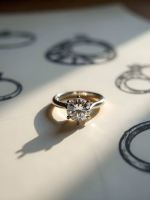Is a lab diamond a real diamond?Discover how lab-grown diamonds match their mined counterparts in every way—and why experts say you can’t tell the difference without special tools!
Lately, lab-grown diamonds have become the shining stars of engagement diamond rings. As per a market study by (source), the lab-grown diamond market reached $22.3 billion in 2021 and is expected to exceed $55.6 billion by 2031. This surge is a result of improvements in the production methods, a turn towards more sustainable choices and a rising acceptance of these alternative gems world over.
However, there are several concerns regarding lab-grown diamonds, including the perception that they are not the same as natural diamonds, despite having identical physical and chemical properties.
So is a lab created diamond a real diamond? We can conclusively confirm that Lab-grown diamonds are as real as mined or natural diamonds. They have the same chemical and physical properties as natural diamonds, which means they will pass standard diamond tests, such as thermal and electrical conductivity tests.
While most lab diamonds will be identified as equivalent to natural diamonds by these testers, some advanced testing methods can differentiate them from mined diamonds. For example, specialized equipment like the DiamondView can reveal differences in fluorescence patterns and growth characteristics, allowing experts to identify the origin of the diamond.
To understand this further we are breaking it down:
1. Understanding Lab-Created Diamonds
How exactly does one create a diamond in the lab? Well, it’s all about copying the natural process that happens deep within the earth, and scientists have two primary ways of doing this: High Pressure High Temperature (HPHT) and Chemical Vapor Deposition (CVD).
First is the HPHT process. A tiny diamond seed gets placed into a bed of carbon. It’s then subjected to temperatures between 1,500 and 1,600 degrees Celsius and pressurized with at least 870,000 pounds per square inch. This intense heat melts the carbon, surrounding the seed and leading to the formation of a diamond.
Besides the extreme heat and pressure method, there is the CVD method. In this, a diamond seed is put in a sealed chamber that’s then filled with a carbon-rich gas. The chamber is heated up to 900-1,200 degrees Celsius. This leads to the gas molecules breaking down, setting free carbon atoms that immediately latch onto the diamond seed and crystallize. Layer upon layer, these atoms build up and in a matter of weeks a diamond emerges.
2.How Diamond Testing Works
Diamond testers work by measuring a gemstone's thermal or electrical conductivity to determine real diamond vs. lab diamond.
Thermal conductivity
A diamond tester heats the stone with a small electrical current and measures how quickly the heat transfers through the stone. Diamonds have a higher thermal conductivity rate than other gemstones, so they conduct heat faster. However, moissanite can also conduct heat similarly to diamonds, so thermal conductivity testers can't always distinguish between the two.
Electrical conductivity
A diamond tester passes a small electric current through the stone and measures its electrical conductivity. Lab-grown diamonds are often made using different techniques, so their conductivity can differ from natural diamonds.
3. Do Lab-Created Diamonds Pass Diamond Tests?
YES, manufactured diamonds do pass diamond tests and are generally identified as REAL diamonds. They possess the same chemical composition and physical properties as mined diamonds, which is why standard diamond testers—such as those that measure thermal and electrical conductivity—typically confirm their authenticity.
However, it's important to note that while most lab-grown diamonds will pass these tests, some advanced testing methods can differentiate them from natural diamonds. For instance, specialized tools like the DiamondView can detect differences in fluorescence patterns and growth characteristics, which may indicate whether a diamond is lab-grown or mined.
4. Differentiating Lab-Created from Mined Diamonds
As a layman can't tell the difference between a lab-grown and a mined diamond with the naked eye, but there are some ways to identify them:
- Nitrogen content: Natural diamonds have trace amounts of nitrogen, while lab-grown diamonds do not.
- Thermal conductivity: Some lab-grown diamonds do not react to heat like natural diamonds do.
- Price: Lab-grown diamonds may be priced up to 75% less than natural diamonds.
- Specialized Instruments: Devices like the DiamondView are used to analyze diamonds. These instruments provide detailed images and data on the diamond's internal structure.
- Fluorescence Patterns: Lab-grown diamonds often exhibit unique fluorescence patterns under UV light, which can help differentiate them from mined diamonds
- Growth Characteristics: Trained gemologists examine the growth morphology of diamonds. Lab-grown diamonds may show specific growth features that are not typically found in natural diamonds
- Expert Evaluation: Gemological institutions, such as the Gemological Institute of America (GIA), offer advanced identification services. Experts use a combination of tools and their expertise to determine the origin of a diamond



